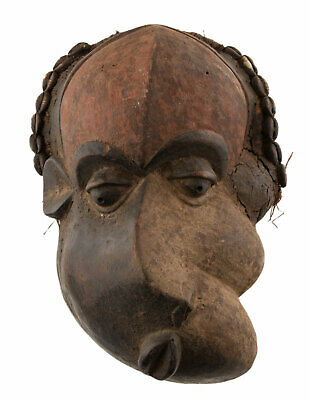-40%
Antique Mask Pende Mbangu Of Disease Coiffe Cowrie Art African DRC 17212
$ 205.64
- Description
- Size Guide
Description
OLD PENDE MBANGU DISEASE MASKMask representing a face disfigured by facial nerve palsy following an epileptic seizure.
Its function is to exorcise ailments such as mutilating leprosy, yaws, smallpox or various forms of paralysis ....
The African "sickness" masks Pende MBangu (deformed mouth) or Bwala-Bwala, illustrate, by their split characteristics, the patient of epileptic seizure or the result of facial paralysis caused by witchcraft rituals.
The dancer who wears this comedy mask wears a hat made of Guinea hen, Coucal or Turaco feathers, or Lumbandou, a crown of leaves.
He's also often fitted with a bump on his back and then exaggerates the character's deactivated appearance.
This Pende mask established at the top of Kwango is distinguished by its slanted nose and deformed mouth.
It is divided into contrasting colors.
The Western Pendes live on the banks of the Kwilu, while the Eastern Pende ethnic group has settled on the banks of the Kasai downstream from Tshikapa.
Influences from neighboring ethnic groups, MBLA, Souku, Wongo, Leele, Kuba and Salempasu inspired their vast tribal artistic sculpture.
In this diversity, the Mbuya masks, realistic, produced every ten years, have a festive function and embody various characters difficult to differentiate without their costume, including the fumu or Ufumu chief, the sabe and his wife, the prostitute, the jester, the Tundu, the possessed, etc ...
Origin Zaire (DRCongo)
Wood, Pigment, kaolin
Perfect balance
Age: Undetermined
Approximate dimensions
: Depth 30 x width 23 x H 34 cm
REF 150721/17212 / BTE ETA AFRI RAD
The African "sickness" masks Pende MBangu (deformed mouth) or Bwala-Bwala, illustrate, by their split characteristics, the patient of epileptic seizure or the result of facial paralysis caused by witchcraft rituals. The Western Pendes live on the banks of the Kwilu, while the Eastern Pende ethnic group has settled on the banks of the Kasai downstream from Tshikapa. Influences from neighboring ethnic groups, MBLA, Souku, Wongo, Leele, Kuba and Salempasu inspired their vast tribal artistic sculpture. In this diversity, the Mbuya masks, realistic, produced every ten years, have a festive function and embody various characters difficult to differentiate without their costume, including the fumu or Ufumu chief, the sabe and his wife, the prostitute, the jester, the Tundu, the possessed, etc















